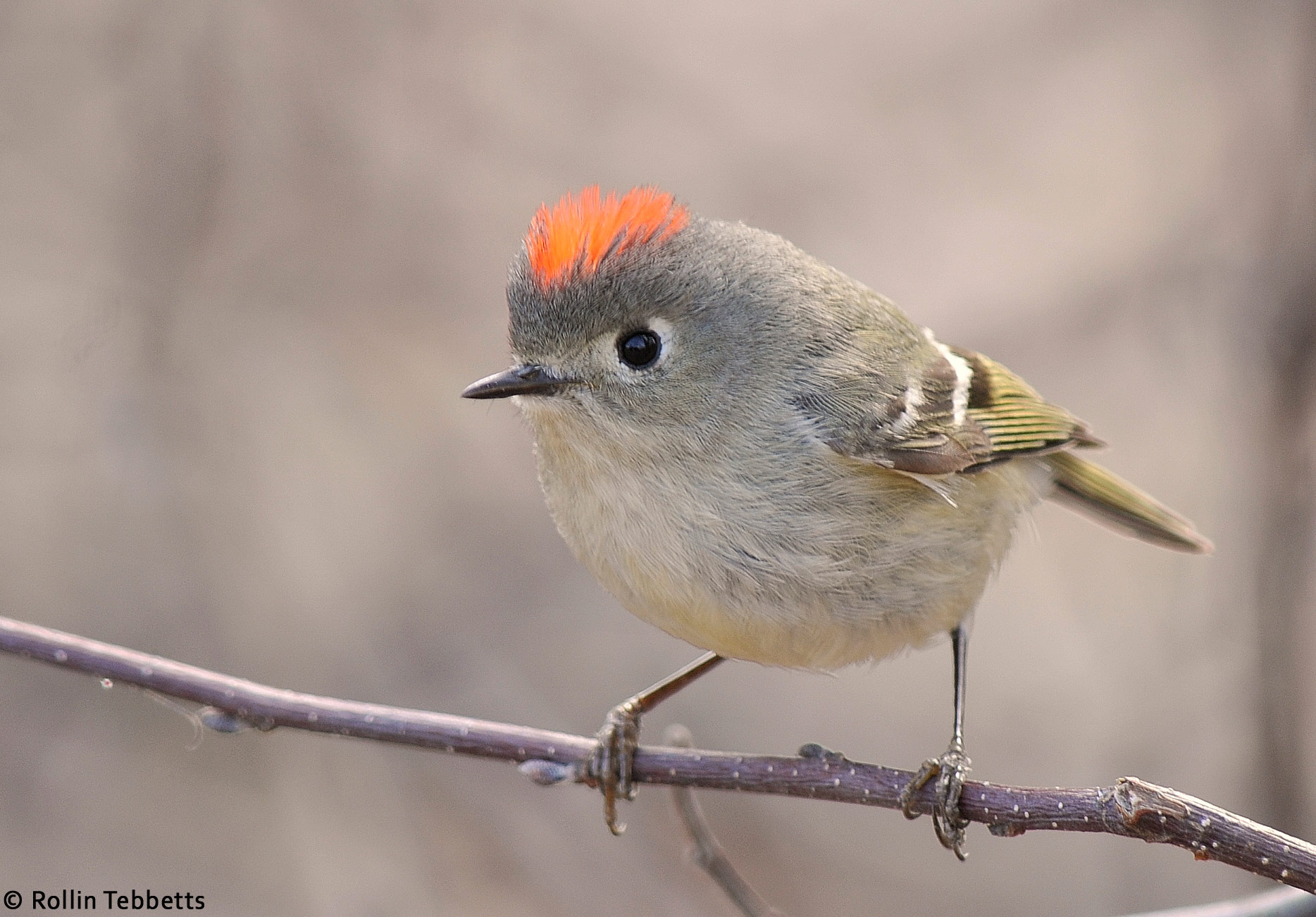April Fireworks
The Kinglet's Court
Most of the time, a male Ruby-crowned Kinglet is a fraud with feathers. When he appears, neither ruby nor kingly, you may wonder how he got his name. Pale green and gray, small and fleeting, he is among the plainest birds in the woods. You may even turn your binoculars instead toward the warbler or woodpecker. But resist the urge to complain or pass him by. Keep watching the kinglet. The reward will be an explosion of feathers that will make your heart pound and your knees wobble.
 From mid-April to early-May, few among us are far from Ruby-crowned Kinglets. Males are rushing north to claim territories in mature coniferous woods. Along the way, they stop to feed and rest in most any woodland or thicket, even your own backyard. That’s when they offer us essential lessons on how to enjoy birds during spring migration. So here’s a quick lesson.
From mid-April to early-May, few among us are far from Ruby-crowned Kinglets. Males are rushing north to claim territories in mature coniferous woods. Along the way, they stop to feed and rest in most any woodland or thicket, even your own backyard. That’s when they offer us essential lessons on how to enjoy birds during spring migration. So here’s a quick lesson.
First, be stealthy. Bright colors and white T-shirts are fashion violations in a birdwatcher’s wardrobe. Be alert yet relaxed, with smooth, easy movement. Nothing spooks a kinglet or other forest bird more effectively than sudden motion; even raising your binoculars from chest to eyes can send a nearby songbird off into the woods. So slow down in every way, which is good advice for doing most anything in the woods. If you rush, the kinglet cannot teach you your lesson in humility.
His first clue is audible. Most songbirds sing during migration. I hear about 80 percent of a woodland’s spring birds long before I see them. And in the dawn symphony, the kinglet, this rather plain bird, would make Sinatra blush. Here is what he sings (read it aloud and accelerate as you go): tee-tee-tee-tee, tew-tew-tew-tu-tu-tu-tu, teedle-dee! teedle-dee! teedle-dee!That long, rich blast of notes makes me swoon (despite, best as I can tell, my lack of female kinglet genes). But the show only gets better from there.
Most of the time, the male’s ruby crown is inconspicuous or little more than a crimson wisp. But when he sings in the presence of a female, he begins to show his mettle – those feathers become, well, erect. It is intended to be a turn-on for females. But when another male enters the scene, the courtship drama shifts to fireworks.
In the company of a competing male, the Ruby-crowned Kinglet unleashes shock and awe. He leans forward, cocks his tail high, sings with vigor, and sends a bolt of energy to his crown. It explodes in a ruby flash, as if flames were erupting from his head. Facing his rival, he jerks from side to side in the songbird equivalent of bucks locking horns. Biologists call it “agonistic behavior.” I call it one of birdwatching’s finest moments.
Photo Credit: Many thanks to Rollin Tebbetts for the kinglet photo featured at the top of this post. A native of Cabot, Vermont, Rollin has a knack for finding rare birds and getting great photos of them. His may be the best Ruby-crowned Kinglet image on the planet.


I live in Brentwood, can about an HR east of sf. I have one who looks in my window every day. Where do they go fr here?
By all means. Probably coming through now!
Would this bird appear in New Brunswick Canada?
Passing through now! I’ve just seen my first of the season hear at home in Montpelier.
Hi, Bryan.
I know it’s asking a lot without a recording, but I’ve been hearing a bird who is in the woods now who has a song similar in length to the kinglet. ( I think you might have helped me out with this once before!) If you could give me a few possibilities, I can look them up. I really want someone to invent an app that you could use in real time that would id bird songs!
Thanks, for these updates! I love them.
I have not heard of this little birdie before, and what a loss for me! Can’t wait to find one. That’s just about the cutest little creature ever.
I enjoyed a flock of these little birds on Tripp Rd, off of Rte 14, this past Sunday (4-21)–didn’t seem to have any fear of me, while I was taking photos and enjoying the sunshine.
Thanks so much, Bryan! Now I can sleep at night.
Louise
Hi Louise,
That would be a displaying male Golden-crowned Kinglet, which shows a lot of orange this time of year.
Best,
Bryan
So can anyone tell me what we saw two days ago that looks incredibly similar to the kinglet, including the striking bright orange crown that was barely visible much of the time, but when another individual came near it, burst into a dazzling display as seen in some of these pics. The only problem is that this bird definitely had a black stipe just over the eye. Otherwise a dead ringer for a kinglet, including nonstop activity high in the branches. We thought it was a warbler, as it seemed maybe longer and more slender than a kinglet, but could find no match in the bird books.